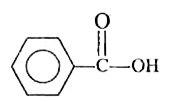Which of the following carboxylic acids is a tricarboxylic acid?
Citric acid
Malonic acid
Succinic acid
Malic acid
The correct Answer is:A
To determine which of the given carboxylic acids is a tricarboxylic acid, we need to analyze the structures of each acid and count the number of carboxyl (-COOH) groups present in each.
1. Identify the acids: The options provided are:
- Citric acid
- Malonic acid
- Succinic acid
- Malic acid
2. Draw the structure of Citric Acid:
- Citric acid has the following structure:
- It contains three carboxyl groups.
- The structure can be represented as:
HOOC−CH2−C(OH)(COOH)−CH2−COOH
- Count the carboxyl groups:
- There are 3 carboxyl groups.
3. Draw the structure of Malonic Acid:
- Malonic acid has the following structure:
- It contains two carboxyl groups.
- The structure can be represented as:
HOOC−CH2−COOH
- Count the carboxyl groups:
- There are 2 carboxyl groups.
4. Draw the structure of Succinic Acid:
- Succinic acid has the following structure:
- It also contains two carboxyl groups.
- The structure can be represented as:
HOOC−CH2−CH2−COOH
- Count the carboxyl groups:
- There are 2 carboxyl groups.
5. Draw the structure of Malic Acid:
- Malic acid has the following structure:
- It contains two carboxyl groups.
- The structure can be represented as:
HOOC−CH(OH)−CH2−COOH
- Count the carboxyl groups:
- There are 2 carboxyl groups.
6. Conclusion:
- From the analysis, only citric acid contains three carboxyl groups, making it a tricarboxylic acid.
- Therefore, the correct answer is Citric Acid.
Final Answer:
Citric Acid is the tricarboxylic acid.
- Citric acid
- Malonic acid
- Succinic acid
- Malic acid
- Citric acid has the following structure:
- It contains three carboxyl groups.
- The structure can be represented as:
HOOC−CH2−C(OH)(COOH)−CH2−COOH
- Count the carboxyl groups:
- There are 3 carboxyl groups.
- Malonic acid has the following structure:
- It contains two carboxyl groups.
- The structure can be represented as:
HOOC−CH2−COOH
- Count the carboxyl groups:
- There are 2 carboxyl groups.
- Succinic acid has the following structure:
- It also contains two carboxyl groups.
- The structure can be represented as:
HOOC−CH2−CH2−COOH
- Count the carboxyl groups:
- There are 2 carboxyl groups.
- Malic acid has the following structure:
- It contains two carboxyl groups.
- The structure can be represented as:
HOOC−CH(OH)−CH2−COOH
- Count the carboxyl groups:
- There are 2 carboxyl groups.
- From the analysis, only citric acid contains three carboxyl groups, making it a tricarboxylic acid.
- Therefore, the correct answer is Citric Acid.
Citric Acid is the tricarboxylic acid.
Similar Questions
Knowledge Check
Which of the following carboxylic acids undergoes decarboxylation most easily on heating?
ACH3CH2COOHBCH3−O∣∣C−COOHCCH3−O∣∣C−CH2−O∣∣C−OHD
Which of the following carboxylic acid undergoes decarboxylation easily ?
AC6H5−CO−CH2−COOHBC6H5−CO−COOHCC6H5−C∣OHH−COOHDC6H5−C∣NH2H−COOHWhich of the following carboxylic acid undergoes decarboxylation easily ?
AC6H5−CO−CH2−COOHBC6H5−CO−COOHCC6H5−C∣OHH−COOHDC6H5−C∣NH2H−COOH
Which of the following on oxidation can give a carboxylic acid in one step ?
View SolutionWhich of the following carboxylic acid undergoes decarboxylation easily ?
View SolutionWhich of the following carboxylic acids is difficult to decarboxylate?
View SolutionWhich of the following carboxylic acids do not undergo decarboxylation simply on heating?
View SolutionWhich of the following carboxylic acids is highly insoluble in water
View Solution
